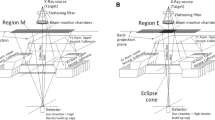Aim:
The photons and electrons backscattered from the upper and lower secondary collimator jaws give rise to a significant increase in the ion charge measured by the monitor chamber, and this increase varies between different accelerators. We have studied the effect of backscatter into the monitor chamber at 6 MV and 18 MV photon energies for the linear accelerator Clinac-1800.
Materials and Methods: The variation of the output factor was first studied for variable asymmetric fields of fixed field size defined by variable right upper collimator jaw together with a variable Cerrobend block low melting point alloy, with constant lower jaw position. Output measurements were carried out at Dmax in a polystyrene phantom at the geometric center of the asymmetric field. The backscatter radiation effect was also analyzed applying a pair of 20 × 20 × 7.5 cm Cerrobend alloy blocks with 6.0 mm diameter pin-holes in the center aligned telescopically with the field defining light beam. The ion chamber with build-up cap was placed at 25 cm behind the second pin-hole. The in air measurements were made varying upper and lower collimators individually and together. For comparison, a similar study was conducted in a Theratron-780C cobalt-60 beam.
Results: In the asymmetric field experiment it was noticed that till the collimator jaw crosses the midline, the output factor is almost constant for 6 and 18 MV photon beams. For extreme field asymmetry, the decreases in output factor were 3.2% and 4.3% for 6 and 18 MV, respectively. The telescopic experiment demonstrated 4.0% and 3.9% reduction in output factor for 6 and 18 MV beams when only the upper jaws were varied. Field definition by the lower jaws only reduced the output factor by 3.3% and 3% for 6 and 18 MV photon beams. For square fields achieved by both the jaws, the output factor variation was similar to that achieved with the upper collimator for both energies. Cobalt-60 measurements with the telescopic arrangement did not show significant dependency of output with field variation, provided that the field-dependent scatter from source capsule and collimator jaws is excluded.
Conclusion: From this study a maximum reduction of 4% and 4.3% in dose delivery was observed for 6 MV and 18 MV photon beams due to backscattered radiation originating mainly from upper collimator reaching the beam monitor chamber. For asymmetric fields it is felt that direct output measurement is more reliable in order to avoid errors in output factor due to radiation backscattered from the collimator jaws into beam monitor chamber.
Ziel:
Die von den oberen und unteren Kollimatorblöcken rückgestreuten Photonen und Elektronen führen zu einer – bei den verschiedenen Akzeleratoren unterschiedlichen – bedeutenden Zunahme der messbaren Ionenladung. Wir haben den Effekt dieser Rückstrahlung für den Linearbeschleuniger Clinac-1800 bei 6-MV- und bei 18-MV-Photonenenergie untersucht.
Material und Methode: Die Variabilität des Austrittfaktors wurde zunächst an unterschiedlichen asymmetrischen Feldern definierter Größe untersucht, die bei konstanter Position des unteren Kollimatorblockes festgelegt war durch den verschiebbaren oberen rechten Kollimatorblock sowie einen verschiebbaren Block aus Cerrobend, einer bei niedriger Temperatur schmelzenden Legierung. Die austretende Strahlung wurde bei Dmax an einem Polysterolphantom im geometrischen Zentrum des asymmetrischen Feldes gemessen. Der Rückstreueffekt wurde außerdem mit einem Paar 20 × 20 × 7,5 cm großer Cerrobend-Blöcke untersucht, deren Lochung (ø 6 mm) teleskopartig mit den das Feld begrenzenden Lichtstrahlen eine Linie bildete. Die Ionisierungskammer befand sich 25 cm hinter der zweiten Lochung. Bei den Messungen in Luft wurden die oberen und unteren Kollimatorblöcke einzeln oder zusammen verändert. Zum Vergleich wurden ähnliche Untersuchungen für Theratron-780C-Kobalt-60-Strahlen durchgeführt.
Ergebnisse: Im asymmetrischen Feld wurde festgestellt, dass, solange der Kollimatorblock die Mittellinie nicht überquert, der Austrittfaktor für 6- und für 18-MV-Photonenstrahlen fast konstant ist. Bei extremer Feldasymmetrie nahm der Austrittfaktoren für 6- und für 18-MV-Photonen um 3,2 bzw. 4,3% ab. Die teleskopische Analyse unter Verwendung der gelochten Cerrobend-Blöcke ergab für 6- und für 18-MV-Photonenstrahlung eine Verminderung des Austrittfaktors um 4,0 bzw. 3,9% wenn nur die oberen Blöcke verschoben wurden. Eine Felddefinition allein durch die unteren Blöcke verminderte den Austrittfaktor für 6 und 18 MV um 3,3 bzw. 2,0%. Wurden mit beiden Kollimatorblöcken quadratische Felder erzeugt, so veränderte sich der Austrittfaktor für beide Photonenenergiewerte in ähnlicher Weise wie durch Verschieben des oberen Blockes. Kobalt-60-Messungen mit der teleskopartigen Anordnung ergaben für die Austrittstrahlung keine signifikante Abhängigkeit von den Feldveränderungen, falls feldabhängige Streuung am Gehäuse der Strahlungsquelle und an den Kollimatorblöcken ausgeschlossen wird.
Schlussfolgerung: In diese Untersuchung wurde für 6- und für 18-MV-Photonen eine maximale Dosisreduktion um 4 bzw. 4,3% beobachtet, die vor allem der Rückstreuung am oberen Kollimatorblock zuzuschreiben ist. Für asymmetrische Felder scheint die direkte Messung der Austrittstrahlung zuverlässiger, um Fehler beim Ermitteln des Austrittfaktors zu vermeiden.
Similar content being viewed by others
Author information
Authors and Affiliations
Additional information
Received: August 11, 2000; accepted: September 19, 2001
Rights and permissions
About this article
Cite this article
Ravikumar, M., Ravichandran, R. Measurement of Backscattered Radiation from Secondary Collimator Jaws into the Beam Monitor Chamber from a Dual Energy Linear Accelerator. Strahlenther Onkol 177, 670–675 (2001). https://doi.org/10.1007/PL00002382
Issue Date:
DOI: https://doi.org/10.1007/PL00002382




